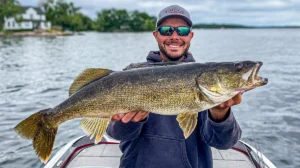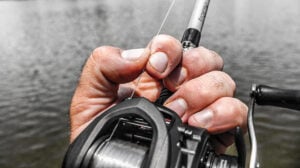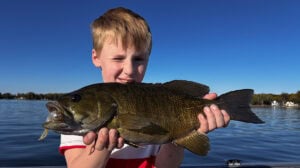Like many avid anglers, my sheer fascination and love of this great sport began on the muddy, ant hill-covered banks of a local farm pond. Every day, rain or shine, I would rush home from school, determined to further my quest of catching my personal best bass. Forget homework, projects or chores—all of that could wait. I fished every single day, only coming home when my parents told me supper was ready. Maybe this explains why I didn’t have many close friends growing up, because I would have much rather been clearing new paths on the shoreline of J.P. Wallis’ farm pond to get better casts towards the “magic” fallen tree than sitting inside playing video games.
I remember being invited to fish on a big lake for the first time as a child. I was nervous. What if my buddy didn’t think I was good? Surely I didn’t have all the expensive gear he had. I’d never skipped docks before, so what if I got hung up? Would he get frustrated? If I didn’t catch anything, would he invite me along for a second trip? Although I didn’t bring much knowledge or experience to the table, I did bring one thing along that proved invaluable—a single tackle tray chock-full of my most trusted farm pond baits. That’s all I had. With that one box, I caught more bass than my buddy that day and the same lures are still producing bass for me when conditions get tough.
To this day, I still carry a box of farm pond baits in my boat wherever I go. Five of these baits have consistently produced nice bass during some tough fishing days on big lakes.
1/4-ounce Arbogast Jitterbug
Just because the Jitterbug has a worldwide reputation of catching huge bass throughout the nighttime hours, don’t think that it doesn’t catch ‘em up during the day, too. Producing a wide, lifelike wobble unlike any other bait on the market, the Jitterbug will catch some really big fish in both farm ponds and highly pressured lakes. Not too many fishermen throw this lure on big lakes, allowing anglers the rare opportunity to present the bass with something they’re largely unfamiliar with.
To get the most out of the Arbogast Jitterbug, make long casts paralleling grass lines or any wood cover. Start out with a slow, steady reeling action while incorporating occasional pauses into your retrieve cadence near key irregularities. Bass can get pretty mad at this lure, so hold on and don’t lift your rod tip until you feel the fish. I also like to replace the stock hooks with No. 6 or No. 4 Mustad Triple Grip Short Shank Hooks to ensure a good connection with the fish.
1/6-ounce Worden’s Rooster Tail
Growing up, many of us spent countless Saturday afternoons relying on the fish catching abilities of this classic bait. Often times, if the bass weren’t eating a Rooster Tail, I was out of luck because that was all I’d have. I began throwing it on big lakes a few years ago, and have mercy—you’re talking about some serious fun. Even better, this lure is great for both serious and casual anglers. If you need a limit fish in a high-pressure tournament situation and only have a few minutes to catch it, don’t be afraid to tie on a Rooster Tail. Conversely, if you like to head to the lake and simply feel something tug on your line, virtually everything that swims will eat a white and silver Rooster Tail.
There isn’t a wrong way to fish a Rooster Tail, but it’s extremely important to pay close attention to the cadence of your retrieve. When you get a bite, make sure to take note of what speed you were reeling in order to duplicate it. As with most moving baits, bass can get very picky when it comes to the retrieval speed of a Rooster Tail, but when you find that “sweet spot” you can fill the boat in a hurry. A pump and drop retrieve works very well in deep water and even on “ledge bass” on big reservoirs.
1/8-ounce Z Man Micro Series Chatterbait
The Z Man Micro Series Chatterbait is one of the most reliable crossover bass baits you will ever find. Priced affordably and coming straight out of the package with quality, dependable components, the Micro Series Chatterbait can draw some vicious strikes. With a small finesse profile coupled with the intense vibration of its hex-blade, this bait is a unique combination of a jig, a spinnerbait and a crankbait. I have caught bass weighing more than 6-pounds in both farm ponds and big lakes with this very lure. Whenever I have newcomers in my boat, I hand them this bait.
We have caught bass on a Micro Series Chatterbait in almost anyway imaginable—jigging, bouncing, dragging, ripping, waking, hopping, flipping—the list could go on. While the Micro Series especially excels in clear water around finicky fish, it can be used in almost any situation. Fish eat the Micro Series Chatterbait—they don’t swat at it. For this reason, we’ve experienced an excellent hookup/landing ratio with this bait.
1/4-ounce Johnson Beetle Spin
Widely considered an “old faithful” fishing lure to many old school anglers, the Johnson Beetle Spin continues to catch fish when other baits fall short. With a free-moving jig head, this lure has a very distinctive “swaying” action in the water that has been often imitated, but never duplicated. The Beetle Spin also provides fishermen with a wide range of versatility—if the shallow water bass aren’t biting, you can easily remove the spinner and use it for deep water jigging. We also will replace the bug body with a Zoom Fat Albert Grub for added action and a big profile at times.
For shallow water approaches, the Beetle Spin is most effective when fished parallel to grass lines or long laydowns. While a constant retrieve will certainly catch fish, intermittent jerks of the rod tip can entice some extra bites as well. For deeper applications, the Beetle Spin’s jig head works great around rock piles and docks.
Zoom 6-inch Lizard
The Zoom Lizard is a fish catching machine and one of my all-time favorite flipping baits. While many anglers prefer to use these lizards exclusively throughout the spring, bass will eat them all year long. Great for Carolina rigs, Texas rigs and even weightless presentations, the Zoom Lizard is a versatile and durable bait that will catch plenty of fish for both serious and casual anglers alike.
When targeting shallow fish, flip the Texas rigged Zoom Lizard into laydowns, underneath docks, along grass lines and around bass beds for the best results. To maintain realism, slowly dragging the lizard is often all that’s necessary to draw some bone-jarring bites. For deep fishing, dragging a Carolina rigged Zoom Lizard around isolated cover on primary points and channel ledges can catch some monster bass.
Many bass anglers, myself included, tend to get caught up in the “latest and greatest” of the fishing industry. While newer, high-end baits can definitely catch a lot of fish, we need to remember our roots and hang on to the lures that started our obsession with bass fishing. If you’re a farm pond angler, don’t be embarrassed to whip out some of these baits when fishing a big lake with a buddy—you might just surprise both your fishing partner and the bass.















